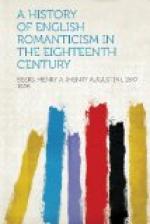Reverting then to our tentative definition—Heine’s definition—of romanticism, as the reproduction in modern art and literature of the life of the Middle Ages, it should be explained that the expression, “Middle Ages,” is to be taken here in a liberal sense. Contributions to romantic literature such as Macpherson’s “Ossian,” Collins’ “Ode on the Superstitions of the Scottish Highlands,” and Gray’s translations form the Welsh and the Norse, relate to periods which antedate that era of Christian chivalry and feudalism, extending roughly from the eleventh century to the fifteenth, to which the term, “Middle Ages,” more strictly applies. The same thing is true of the ground-work, at least, of ancient hero-epics like “Beowulf” and the “Nibelungen Lied,” of the Icelandic “Sagas,” and of similar products of old heathen Europe which have come down in the shape of mythologies, popular superstitions, usages, rites, songs, and traditions. These began to fall under the notice of scholars about the middle of the last century and made a deep impression upon contemporary letters.
Again, the influence of the Middle Age proper prolonged itself beyond the exact close of the medieval period, which it is customary to date from the fall of Constantinople in 1453. The great romantic poets of Italy, Boiardo, Ariosto, Tasso, wrote in the full flush of the pagan revival and made free use of the Greek and Roman mythologies and the fables of Homer, Vergil, and Ovid; and yet their work is hardly to be described as classical. Nor is the work of their English disciples, Spenser and Sidney; while the entire Spanish and English drama of the sixteenth and seventeenth centuries (down to 1640, and with an occasional exception, like Ben Jonson) is romantic. Calderon is romantic; Shakspere and Fletcher are romantic. If we agree to regard medieval literature, then, as comprising all the early literature of Europe which drew its inspiration from other than Greek-Latin sources, we shall do no great violence to the usual critical employment of the word. I say early literature, in order to exclude such writings as are wholly modern, like “Robinson Crusoe,” or “Gulliver’s Travels,” or Fielding’s novels, which are neither classic nor romantic, but are the original creation of our own time. With works like these, though they are perhaps the most characteristic output of the eighteenth century, our inquiries are not concerned.
It hardly needs to be said that the reproduction, or imitation, of mediaeval life by the eighteenth- and nineteenth-century romanticists, contains a large admixture of modern thought and feeling. The brilliant pictures of feudal society in the romances of Scott and Fouque give no faithful image of that society, even when they are carefully correct in all ascertainable historical details.[1] They give rather the impression left upon an alien mind by the quaint, picturesque features of a way of life which seemed neither quaint nor picturesque to the men who lived




